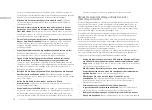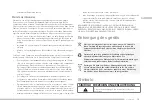
8
cramer.eu
EN
Check the amount of oil in the chain saw by looking at the oil level gauge. If
the oil level is low, follow the steps shown in section “ADDING CHAIN & BAR
LUBRICANT” of this manual.
Holding the chain saw
(see
Figure 8
)
Always hold the chain saw with your right hand at the rear handle and your left
hand at the front handle.
Grip both handles with the thumbs and the hands. Ensure that your left hand is
holding the front handle so that your thumb is underneath.
Starting operation
(see
Figure 2
)
1
Before starting for operation, you should install the battery pack in the
machine.
2
Start the machine: Press the safety lock-off button, and then pressure the
switch trigger.
Stopping operation
(see
Figure 2
)
1
Release the switch trigger to stop the chain saw.
Operating the chain brake
(see
Figure 22
)
Check the operating condition of the chain brake prior to each use.
•
Engage the chain brake by rotating your left hand around the front handle,
allowing the back of your hand to push the chain brake lever/hand guard
toward the bar while the chain is rotating rapidly. Be sure to maintain both
hands on the saw handles at all times.
•
Reset the chain brake back into the RUN position by grasping the top of the
chain brake lever/hand guard and pulling toward the front handle.
WARNING!
If the chain brake do not stop the chain immediately, or if the
chain brake will not stay in the run position without assistance,
take the saw to an authorized service center for repair prior to use.
Using the chain saw
Always be sure of your footing and hold the chain saw firmly with both hands
while themotor is running.
Basic felling, limbing, and crosscutting techniques
(see
Figure 9
)
Felling a tree
When bucking and felling operations are being performed by two or more persons
at the same time, the felling operation should be separated from the bucking
operation by a distance of at least twice the height of the tree beingfelled.
Trees should not be felled in a manner that would endanger any person, strike
any utility line or cause any property damage.If the tree does make contact with
any utility line, the utility company should be notified immediately. The chain saw
operator should keep on the uphill side of the terrain as the tree is likely to roll
or slide downhill after it is felled. An escape path should be planned and cleared
as necessary before cuts are started. The escape path should extend back and
diagonally to the rear of the expected line of fall. Before felling is started, consider
the natural lean of the tree, the location of larger branches and the wind direction
to judge which way the tree will fall. Remove dirt, stones, loose bark, nails, and
staples from the tree.
NOTCHING UNDERCUT (A NOTCH CUT IN A TREE TO DIRECT THE FALL)
(see
Figure 10
)
Make the notch 1/3 in diameter of the tree, perpendicular to the direction of falls.
Make the lower horizontal notching cut first, this will help to avoid pinching of
either the saw chain or the guide bar when the second notch is being made.
FELLING BACK CUT (THE FINAL CUT IN A TREE FELLING OPERATION, MADE ON THE
OPPOSITE SIDE OF THE TREE FROM THE NOTCHING UNDERCUT)
(see
Figure 10
)
Make the felling back cut at least 50mm higher than the horizontal notching cut.
Keep the felling back cut parallel to the horizontal notching cut.Make the felling
back cut so as to leave enough wood to act as a hinge. The hinge wood keeps the
tree from twisting and falling in the wrong direction.Do not cut through the hinge.
As the felling cut gets close to the hinge, the tree should begin to fall. If there is
Summary of Contents for 40CS12
Page 310: ...DISTRIBUTOR INFO cramer eu ...









































